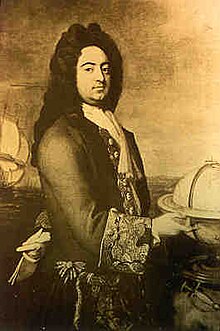
Back فرانسيس نيكلسون Arabic Francis Nicholson German فرانسیس نیکلسون Persian Francis Nicholson French フランシス・ニコルソン Japanese Николсон, Фрэнсис Russian
Francis Nicholson | |
|---|---|
 Alleged portrait of Francis Nicholson. There are no known authentic portraits of Nicholson. | |
| 21st Governor of South Carolina | |
| In office 1721–1725 | |
| Monarch | George I |
| Preceded by | James Moore Jr. |
| Succeeded by | Arthur Middleton (acting) |
| Governor of Nova Scotia | |
| In office 1712–1715 | |
| Monarchs | Anne George I |
| Preceded by | Samuel Vetch |
| Succeeded by | Samuel Vetch |
| Governor of Virginia | |
| In office 1698–1705 | |
| Monarchs | William III Anne |
| Preceded by | George Hamilton |
| Succeeded by | Edward Nott |
| 7th Royal Governor of Maryland | |
| In office 1694–1698 | |
| Monarch | William III |
| Preceded by | Thomas Lawrence |
| Succeeded by | Nathaniel Blakiston |
| Lieutenant Governor of Virginia | |
| In office 1690–1692 | |
| Monarchs | William III and Mary II |
| Preceded by | Nathaniel Bacon (acting) |
| Succeeded by | Sir Edmund Andros |
| Lieutenant Governor of the Dominion of New England | |
| In office 1688–1689 | |
| Monarchs | James II William III and Mary II |
| Personal details | |
| Born | 12 November 1655 Downholme, Yorkshire, England |
| Died | 5/16 March 1727/28 London, England |
| Resting place | St George's Hanover Square Church |
| Profession | Military officer, official |
| Signature | |
| Military service | |
| Allegiance | |
| Branch/service | British Army |
| Years of service | 1680-1727/28 |
| Rank | Lieutenant-General |
| Battles/wars | Monmouth Rebellion |
Lieutenant-General Francis Nicholson (12 November 1655 – 16 March 1728 [O.S. 5 March 1727])[1] was a British Army general and colonial official who served as the governor of South Carolina from 1721 to 1725. He previously was the Governor of Nova Scotia from 1712 to 1715, the Governor of Virginia from 1698 to 1705, the Governor of Maryland from 1694 to 1698, the Lieutenant Governor of Virginia from 1690 to 1692, and the Lieutenant Governor of the Dominion of New England from 1688 to 1689.
Nicholson's military service included time in Africa and Europe, after which he was sent to North America as leader of the troops supporting Governor, Sir Edmund Andros in the Dominion of New England. There he distinguished himself, and was appointed lieutenant governor of the Dominion in 1688. After news of the Glorious Revolution and the overthrow of King James II reached the colonies in 1689, Andros was himself overthrown in the Boston Revolt. Nicholson himself was soon caught up in the civil unrest from Leisler's Rebellion in New York Town, and afterwards fled to England.
Nicholson next served as lieutenant governor or governor of the colonial Provinces of Virginia and Maryland. He supported the founding of the College of William and Mary, at Williamsburg, Virginia, and quarreled with Andros after Andros was selected over him as Governor of Virginia. In 1709, he became involved in colonial military actions during Queen Anne's War (1702-1713, War of the Spanish Succession in Europe), leading an aborted expedition against the French in New France (modern Canada). He then led the expedition that successfully captured Port Royal, Acadia on 2 October 1710. Afterward he served as governor of Nova Scotia and Placentia, and was the first royal governor of the colonial Province of South Carolina following a rebellion against its proprietors. He rose to the rank of Lieutenant-General, and died a bachelor in London, England, in 1728.
Nicholson supported public education in the colonies, and was a member of both the Society for the Propagation of the Gospel in Foreign Parts and the Royal Society. He also influenced American architecture, being responsible for the planned layout and design of colonial/provincial capitals of Annapolis, Maryland and Williamsburg, Virginia. He was one of the earliest advocates of colonial union, principally for reasons of defense against common enemies.
- ^ Nicholson's death was recorded in the Julian calendar as 5 March 1727; in the Gregorian calendar now in use, the date would be 16 March 1728.
© MMXXIII Rich X Search. We shall prevail. All rights reserved. Rich X Search